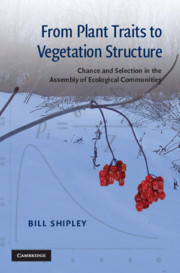 From Plant Traits to Vegetation Structure
From Plant Traits to Vegetation Structure Book contents
- Frontmatter
- Contents
- Preface
- 1 Playing with loaded dice
- 2 Population-based models of community assembly
- 3 Trait-based community ecology
- 4 Modeling trait-based environmental filters: Bayesian statistics, information theory and the Maximum Entropy Formalism
- 5 Community dynamics, natural selection and the origin of community-aggregated traits
- 6 Community assembly during a Mediterranean succession
- 7 The statistical mechanics of species abundance distributions
- 8 Epilogue: traits are not enough
- References
- Index
4 - Modeling trait-based environmental filters: Bayesian statistics, information theory and the Maximum Entropy Formalism
Published online by Cambridge University Press: 05 June 2012
- Frontmatter
- Contents
- Preface
- 1 Playing with loaded dice
- 2 Population-based models of community assembly
- 3 Trait-based community ecology
- 4 Modeling trait-based environmental filters: Bayesian statistics, information theory and the Maximum Entropy Formalism
- 5 Community dynamics, natural selection and the origin of community-aggregated traits
- 6 Community assembly during a Mediterranean succession
- 7 The statistical mechanics of species abundance distributions
- 8 Epilogue: traits are not enough
- References
- Index
Summary
The previous chapter described a verbal model of community assembly: trait-based environmental filtering. This conceptual model views the environmental conditions of a site as a series of “filters” consisting of various selection pressures. These selection pressures reflect the probability of a given species being able to immigrate into the site and then to survive and reproduce. Such demographic probabilities vary between species because each species has a unique set of functional traits and because such functional traits bias these probabilities. The problem with this verbal model is that we don't know how to formally link traits with such probabilities. We now have to build such formal links.
With a chapter title including the words “Bayesian statistics”, “information theory” and the “Maximum Entropy Formalism” you might be tempted to skip to the next one. Please resist this understandable temptation because, although this chapter is more statistical than ecological, it will develop the statistical and mathematical methods upon which the ecological theory is based. If you are a typical reader then you will be reading this book in order to learn about the links between organismal traits and ecological communities. If so then, for you, the theoretical content of the book is only a means to an end. In order to convince you that reading this chapter will be worthwhile let's be clear about what we are trying to accomplish and, equally important, what we are trying to avoid.
- Type
- Chapter
- Information
- From Plant Traits to Vegetation StructureChance and Selection in the Assembly of Ecological Communities, pp. 82 - 143Publisher: Cambridge University PressPrint publication year: 2009


